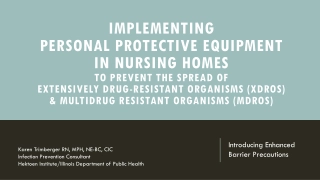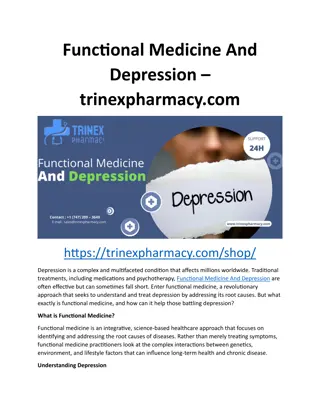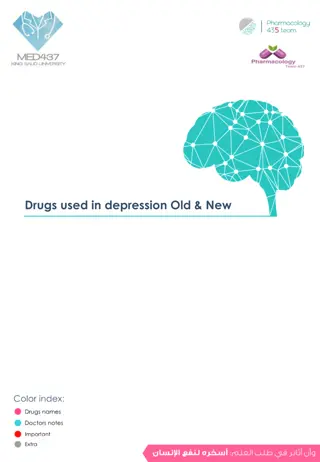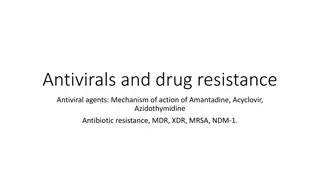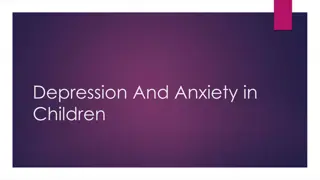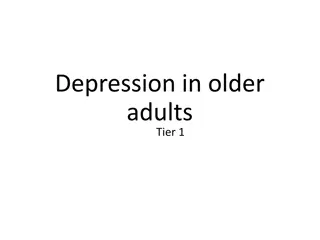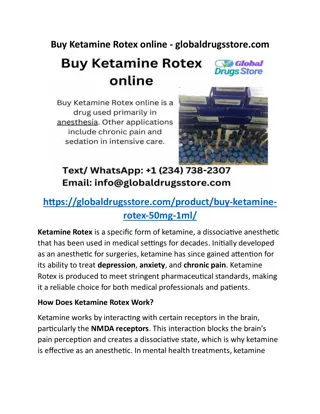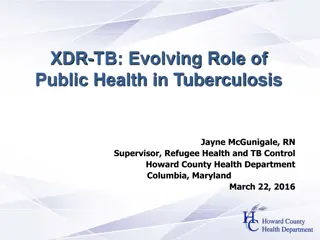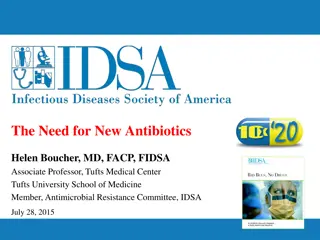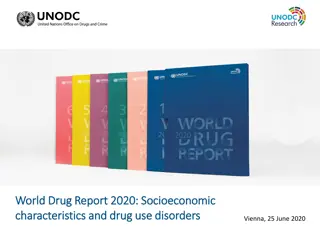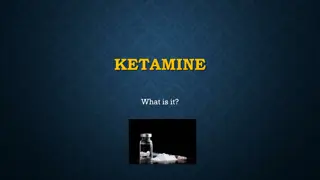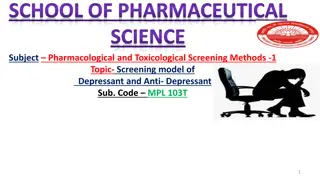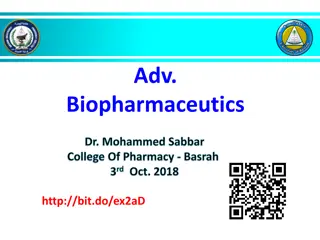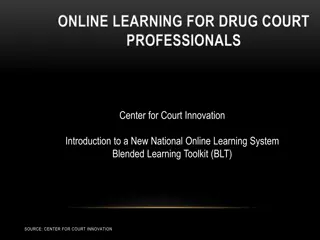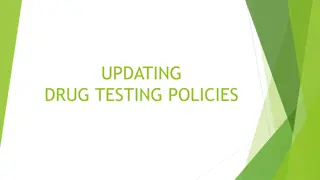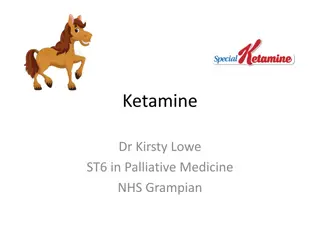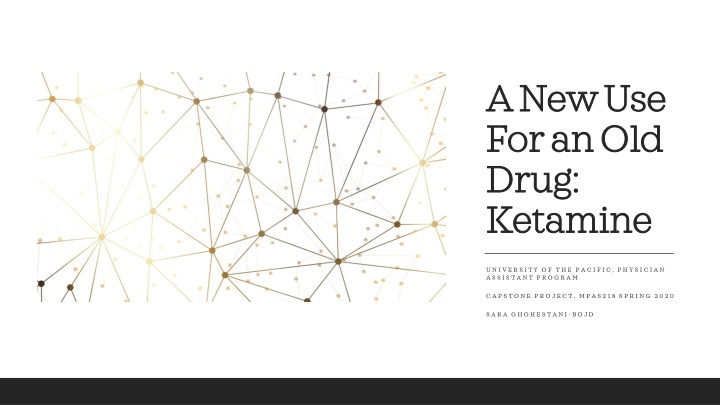
New Use for an Old Drug: Ketamine in Treatment-Resistant Depression.
The potential of Ketamine in addressing Treatment-Resistant Depression (TRD) and its history as an anesthetic. Learn about the definition of TRD, statistics on depression, and the need for innovative treatments. Discover the mechanisms of action and studies showcasing Ketamine's efficacy, with implications for future research and prescribing considerations."
Download Presentation

Please find below an Image/Link to download the presentation.
The content on the website is provided AS IS for your information and personal use only. It may not be sold, licensed, or shared on other websites without obtaining consent from the author. If you encounter any issues during the download, it is possible that the publisher has removed the file from their server.
You are allowed to download the files provided on this website for personal or commercial use, subject to the condition that they are used lawfully. All files are the property of their respective owners.
The content on the website is provided AS IS for your information and personal use only. It may not be sold, licensed, or shared on other websites without obtaining consent from the author.
E N D
Presentation Transcript
A New Use A New Use For an Old For an Old Drug: Drug: Ketamine Ketamine U N I V E R S I T Y O F T H E P A C I F I C , P H Y S I C I A N A S S I S T A N T P R O G R A M C A P S T O N E P R O J E C T , M P A S 2 1 8 S P R I N G 2 0 2 0 S A R A G H O H E S T A N I - B O J D
Disclosures I have, Sara Ghohestani-Bojd, have no conflicts of interest and no disclosures in relation to this presentation. Advising was provided by Dr. RahneaSunseri.
Picot In Patients with Treatment-Resistant Depression, How Effective is Ketamine for Rapid Improvement of Depression and its Symptoms? Question
Learning Objectives Define Treatment Resistant Depression (TRD) Familiarize with statistics of TRD and suicidality. Understand the history of ketamine and how it came to be a drug of interest. Understand potential mechanisms of action which contribute to improvement of symptoms of depression. Review studies showing efficacy. Considerations for future studies. Considerations for the prescriber and potentials of use. Implications for the future.
Background: According to the CDC, major depressive disorder (MDD) has a prevalence of 16.6% in the US. Current well-established treatments for MDD are available, however a large population of patients do not respond to these treatments. Limitations of standard pharmacological antidepressants? According to the CDC, suicide is the 10th leading cause of death in the US and it takes the lives of approximately 45,000 Americans every year.
Defining Treatment-Resistant Depression (TRD) There is no universal consensuson the definition of TRD. However, the most common definition for TRD is the following: TRD is commonly defined as a failure of treatment to produce response or remission for patients with MDD after two or more treatment attempts of adequate dose and duration.
An Early History of Ketamine 1962 CHEMISTS DISCOVERED KETAMINE. 1970 FDA APPROVAL OF KETAMINE FOR USE IN ANESTHESIA. WHY WAS IT SUCH A POPULAR ANESTHETIC? LATE 1970S: THE DOWNFALL OF KETAMINE. EARLY 1990S: KETAMINE S RETURN TO THE SPOTLIGHT.
The First Clinical Trial Berman et al. 2000
We Want More Proof! Zarate et al. 2006
Are They Just Getting High?
Conclusions The overwhelming majority of studies support the conclusion that ketamine does in fact seem to improve TRD in as little as hours up to a few weeks. Currently, trials and research persist in studying these effects and in establishing the best route and dose of administration of ketamine to safely and effectively treat TRD.
Drawbacks and Concerns Potential for abuse? Long-term safety profile? Short term effects? Costs?
Potentials for Use In 2017, a meta-analysis written by Wilkinson et al. showed ketamine has a role in reducing suicidality, independent of its effect of improving depression. The field of EM has much to gain by the development of a fast-acting antidepressant. It may be time to consider the role of ketamine in emergency medicine for suicidal patents.
Kessler RC, BerflundP, DemlerO, JinR, MerikangasKR, Walters EE. Lifetime Prevalence and Age-of-Onset Distributions of DSM-IV Disorders in the National Comorbidity Survey Replication. Archives of General Psychiatry. 2005;62(6):593. Doi:10.1001/archpsyc.62.6.593. L pez-D az , Murillo-IzquierdoM, Moreno-MelladoE. Off-label use of ketamine for treatment-resistant depression in clinical practice: European perspective. British Journal of Psychiatry. 2019;215(2):447-448. doi:10.1192/bjp.2019.102 PapadimitropoulouK, Vossen C, KarabisA, DonattiC, KubitzN. Comparative efficacy and tolerability of pharmacological and somatic interventions in adult patients with treatment-resistant depression: a systematic review and network meta-analysis. C urrMed Res Opin. 2017;33(4):701-711. Doi:10.1080/03007995.2016.1277201 ZanosP, Gould TD. Mechanisms of ketamine action as an antidepressant. Molecular Psychiatry. 2018;23(4):801-811. doi:10.1038/mp.2017.255. Tan S, Wang Y, Chen K, et al. Ketamine alleviates depressive-like behaviors via down-regulating inflammatory cytokines induced by chronic restraint stress in mice. The Pharmaceutical Society of Japan. 2017; Vol. 40, No.8 pp.1260-1267 References McgirrA, BerlimMT, Bond DJ, Fleck MP, YathamLN, Lam RW. A systematic review and meta-analysis of randomized, double-blind, placebo-controlled trials of ketamine in the rapid treatment of major depressive episodes. Psychol Med. 2015;45(4):693-704. Newport DJ, Carpenter LL, McdonaldWM, et al. Ketamine and Other NMDA Antagonists: Early Clinical Trials and Possible Mechanisms in Depression. Am J Psychiatry. 2015; 172(10):950-66. Zarate, C. A. Jr., Singh, J. B., Carlson, P. J., Brutsche, N.E., Ameli, R., LuckenbaughDA, Manji, H. K. (2006).A randomized trial of an N- methyl-D-aspartate antagonist in treatment-resistant major depression.Archives of General Psychiatry,63, 856-64. Murrough, J. W. et al. Antidepressant efficacy of ketamine in treatment-resistant major depression: a two-site randomized controlled trial.Am. J. Psychiatry170 170, 1134 1142 (2013) Wilkinson ST, Ballard ED, Bloch MH,et al.:The effect of a single dose of intravenous ketamine on suicidal ideation: a systematic review and individual participant data meta-analysis.Am J Psychiatry Am J Psychiatry 2018; 175:150 158 BewernickB, SchlaepferTE. Update on neuromodulation for treatment-resistant depression. F1000Rers.2015;4:Rev1389. Doi:10.12688/f1000research.6633.1 Ionescu DF, PapakostasGI. Current trends in identifying rapidly acting treatments for depression. CurrBehavNeurosciRep. 2016;3(2):185- 191. Doi: 10.1007/s40473-016-0075-4

